In addition to Apple's 180-degree turnaround in the design of the new MacBook Pro with 16.2 and 14.2 inches, which can be seen most clearly in the connections and touch bar, those used in the notebooks took care of it new ARM SoCs M1 Pro and M1 Max for the even bigger aha moment on Monday evening. The only thing missing is confirmation by benchmarks.
Apple M1 in large and even larger
It was expected that Apple would properly re-drill the M1 chip (analysis) presented last year, which was previously used in MacBook, MacBook Air, Mac mini and iPad Pro, for the MacBook Pro. Ultimately, it is important to replace CPUs with a high TDP and up to eight cores from Intel and – in the large model – GPUs of the Navi generation from AMD in these devices. But the way in which Apple scaled the M1 Pro and in particular the M1 Max on the basis of the known architecture was surprising in the end.
Already the key data can be read impressive, the performance data promised by Apple do it too. An independent confirmation by benchmarks is still pending. The first tentative practical impressions of the performance are at least already available for the CPU.
Two new dies in 2 × 2 configurations each
The M1 Pro and M1 Max each use their own dies. With the first of the M1, Apple has now released three different M1 dies. Both the M1 Pro and the M1 Max are again available in two chip configurations: each in the presumed full configuration and in a slightly slimmed-down version. The cut affects both the CPU and the GPU in the M1 Pro, but only the GPU in the M1 Max. Each of these variants is in turn available in two memory configurations: With the M1 Pro with 16 or 32 GB, with the M1 Max with 32 or 64 GB.
(TFLOPS) Memory CPU + GPU
(bandwidth) Transistors
(Manufacturing) P cores E cores Apple M1 Max 8 2 32 (10.4) 64 GB (400 GB/s) 57.0 billion (5 nm) 32 GB (400 GB/s) 24 (??) 64 GB (400 GB/s) 32 GB (400 GB/s) Apple M1 Pro 8 2 16 (5.2) 32 GB (200 GB/s) 33.7 billion (5 nm) 16 GB (200 GB/s) 6 14 (??) 32 GB (200 GB/s) 16 GB (200 GB/s) Apple M1 4 4 8 (2.6) 16 GB (68 GB/s) 16.0 billion (5 nm ) 8 GB (68 GB/s) 7 (2.3) 16 GB (68 GB/s) 8 GB (68 GB/s)
In the production process without competition
All three monolithic dies are manufactured in the same 5 nm process at TSMC, which no competitor has used for notebook or desktop chips so far. Only estimates are currently available for the size of the chips, which in turn are still in doubt. With 57 billion transistors (Nvidia GA100: 54 billion, AMD Navi 21: 26.8 billion, Ryzen Threadripper 3990X with 64 cores and I/O-Die: 40 billion) the M1 Max takes up an area of speculated in 5 nm over 400 mm² on the 300 mm wafer in production. That sounds huge at first glance, but considering the fact that Nvidia's GA100 has an area of 826 mm² in 7 nm, the SoC looks almost compact again. The M1 Pro should come to around 250 mm². Apple's biggest chips to date are both.
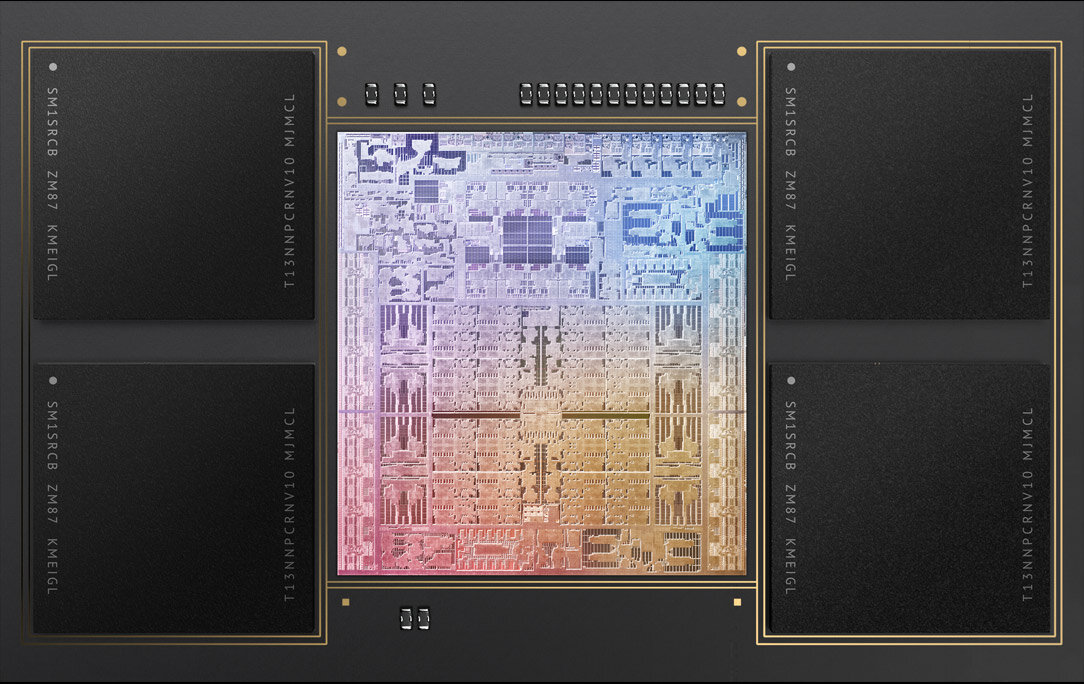
The additional transistors compared to the M1 (M1 Max: +256 percent, M1 Pro: +110 percent) are used by Apple for a different configuration of the CPU cores (8 + 2 vs. 4 + 4) with 24 instead of 12 MB shared L2- Cache for the P cores (the E cores, which are halved compared to M1, remain at 4 MB) and a GPU that has been increased from a maximum of 8 to 32 GPU cores (4,096 ALUs). Apple has left the Neural Engine for accelerating AI algorithms at 16 cores.
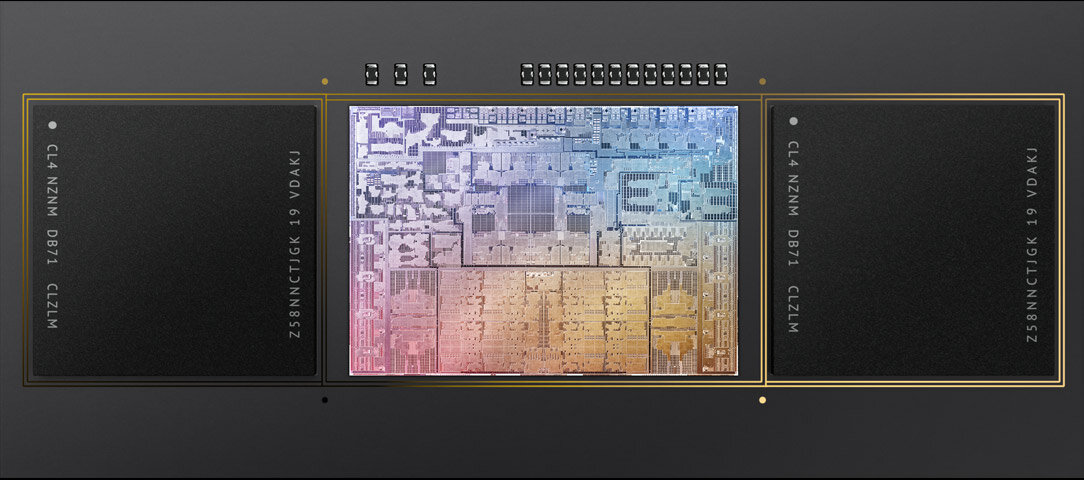 Apple M1 Pro with two memory chips on the 256-bit interface (picture: Apple)
Apple M1 Pro with two memory chips on the 256-bit interface (picture: Apple) Without the I/O -Restrictions of the Apple M1
But Apple has not only drilled out the CPU, GPU and memory interface with the M1 Pro and M1 Max compared to the M1, the I/O functionalities have also been significantly expanded. Both chips offer Thunderbolt 4 with USB 4 with up to 40 Gbit/s each, while the M1 could only provide Thunderbolt 3 (40 Gbit/s) with USB 4 with 10 Gbit/s. And while the M1 only had two of these interfaces, both new MacBook Pros come with three Thunderbolt 4 plus HDMI and SD card readers. It is not known whether the M1 Pro and M1 Max can do even more. In addition, the M1 Pro and M1 Max offer hardware accelerated decoding and encoding of H.264, HEVC, ProRes and ProRes RAW. The M1 Pro has a decoding and an encoding and a ProRes encoding and decoding engine, the M1 Max has one decoding and two encoding and two ProRes encoding and decoding engines.
M1 Max stands for maximum GPU performance
The GPU with up to 32 instead of a maximum of 16 cores and the bandwidth, which has been doubled from 200 to 400 GB/s via a 512 instead of 256 bit wide interface that uses twice as many memory chips, distinguishes the M1 Pro and M1 Max however, no difference – neither on the data sheet nor in the performance data promised by Apple. Compared to the M1, however, it is clearly ahead in both cases, because the number of performance cores has been doubled.
 Apple M1 Pro with 10 CPU and 16 GPU cores (Image: Apple)
Apple M1 Pro with 10 CPU and 16 GPU cores (Image: Apple) 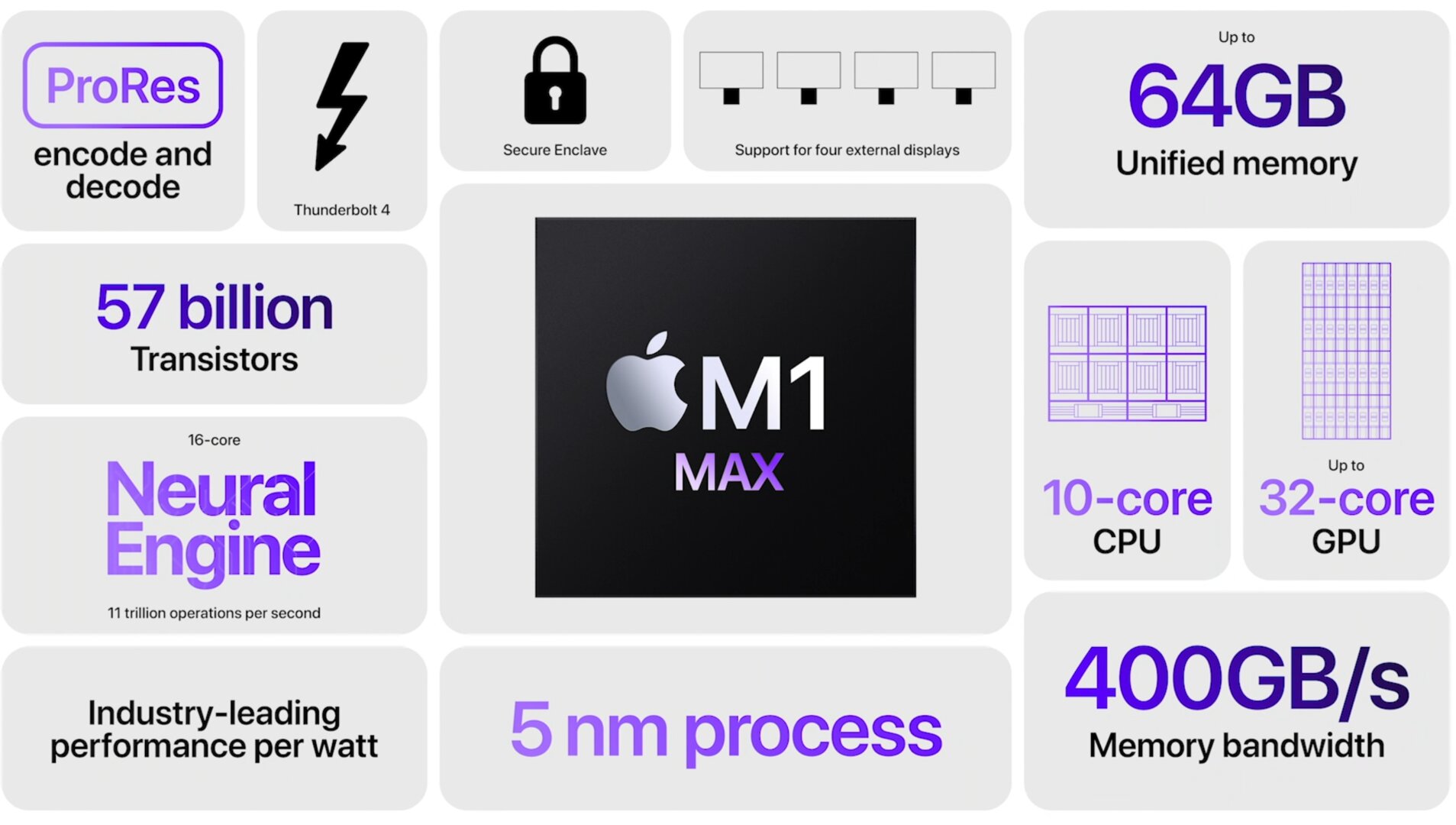 Apple M1 Max with 10 CPU and 32 GPU cores (Image: Apple)
Apple M1 Max with 10 CPU and 32 GPU cores (Image: Apple) Apple promises this performance
The key data presented by Apple are impressive, but in the end What counts is what performance the CPU cores and Apple's own GPU achieve with it. Apple claims: Intel, AMD and Nvidia face huge competition with the large mobile SoCs. However, Apple itself does not yet provide comprehensible test results.
CPU performance
In order to clarify the performance of the CPU in the M1 Pro and M1 Max, which is identically high when fully configured, Apple has used two different perspectives: one from the point of view of performance with 30 watt SoC consumption and once from the point of view of the maximum performance of the competition . An MSI GP66 Leopard 11 UG with Intel's 8-core CPU Core i7-11800H was used. Based on unspecified benchmarks, Apple promises 1.7 times as much CPU performance at 30 watts with the M1 Pro/M1 Max or the same maximum performance as the Core i7 at a little over 60 watts with just under 20 watts at Apple. Apple suggests that 30 watts for the M1 Pro and M1 Max is the maximum consumption under full CPU load, but this has not yet been guaranteed. In addition, it is important to note when looking at Apple's performance data: A Core i7 can also be operated with a higher power loss, as the XMG Neo 15 (M21) recently demonstrated.
-
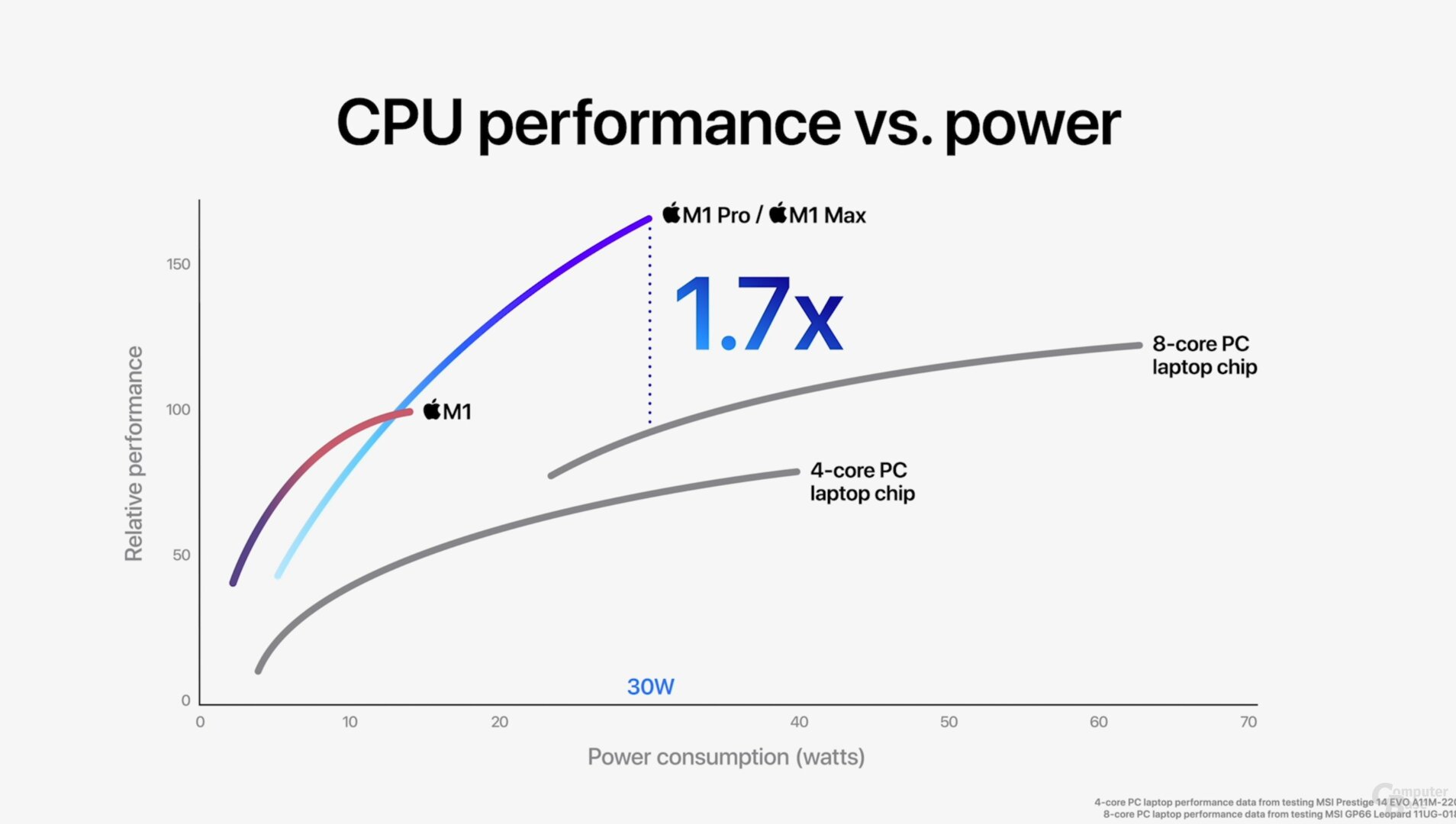 Significantly more CPU -Power with the same consumption
Significantly more CPU -Power with the same consumption
Image 1 of 2
 Significantly more CPU performance with the same consumption
Significantly more CPU performance with the same consumption 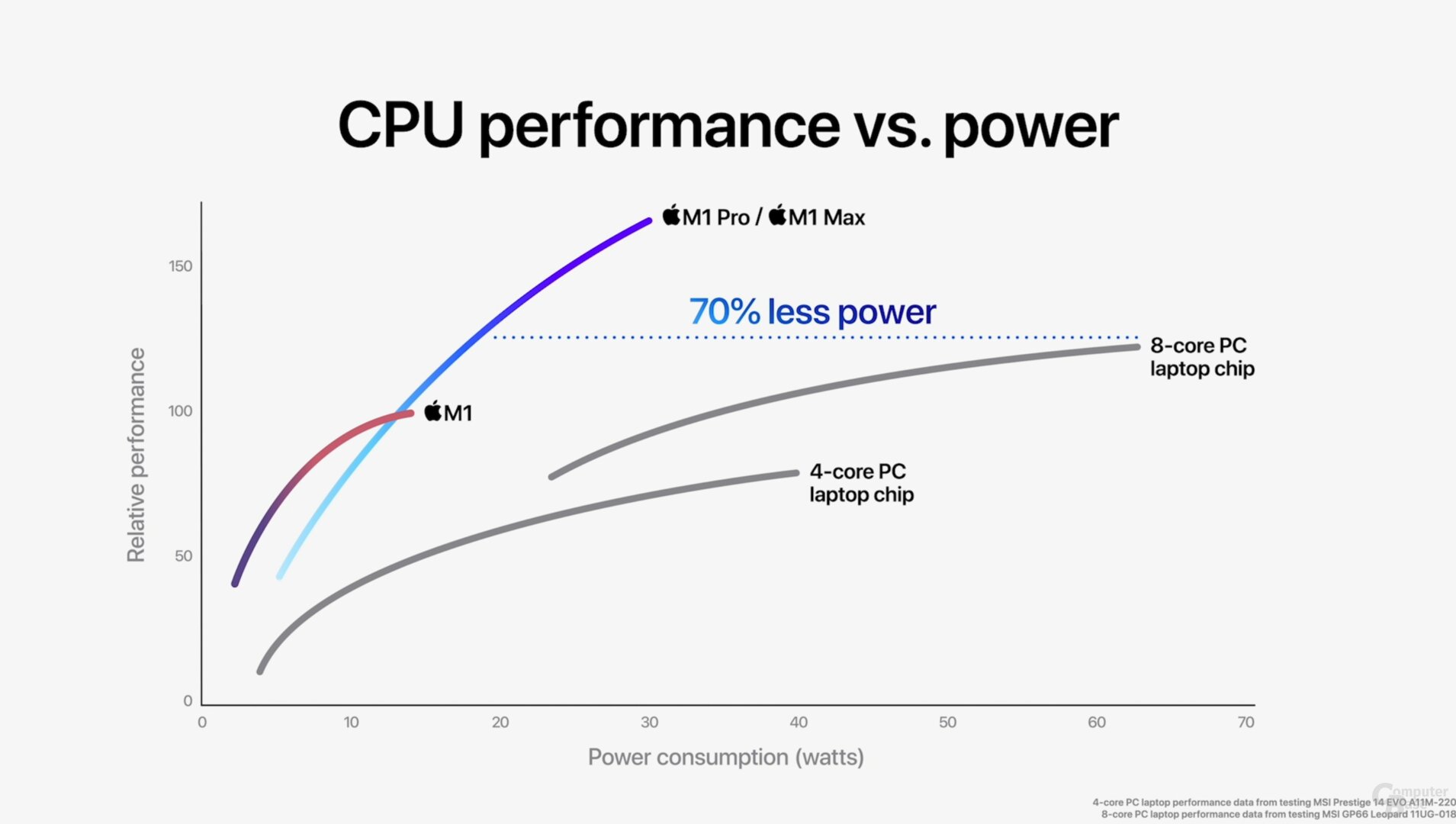 The same top performance with 70 percent less consumption
The same top performance with 70 percent less consumption Compared to the Core i7 and Core i9 CPUs of the last generation MacBook Pro 13.3 inches and MacBook Pro 16.0 inches, Apple wants to have increased the CPU performance by a factor of 2.0 and 3.7 respectively by switching to the M1 Pro and M1 Max. In this case, too, Apple does not provide details on the basis for this comparison.
-
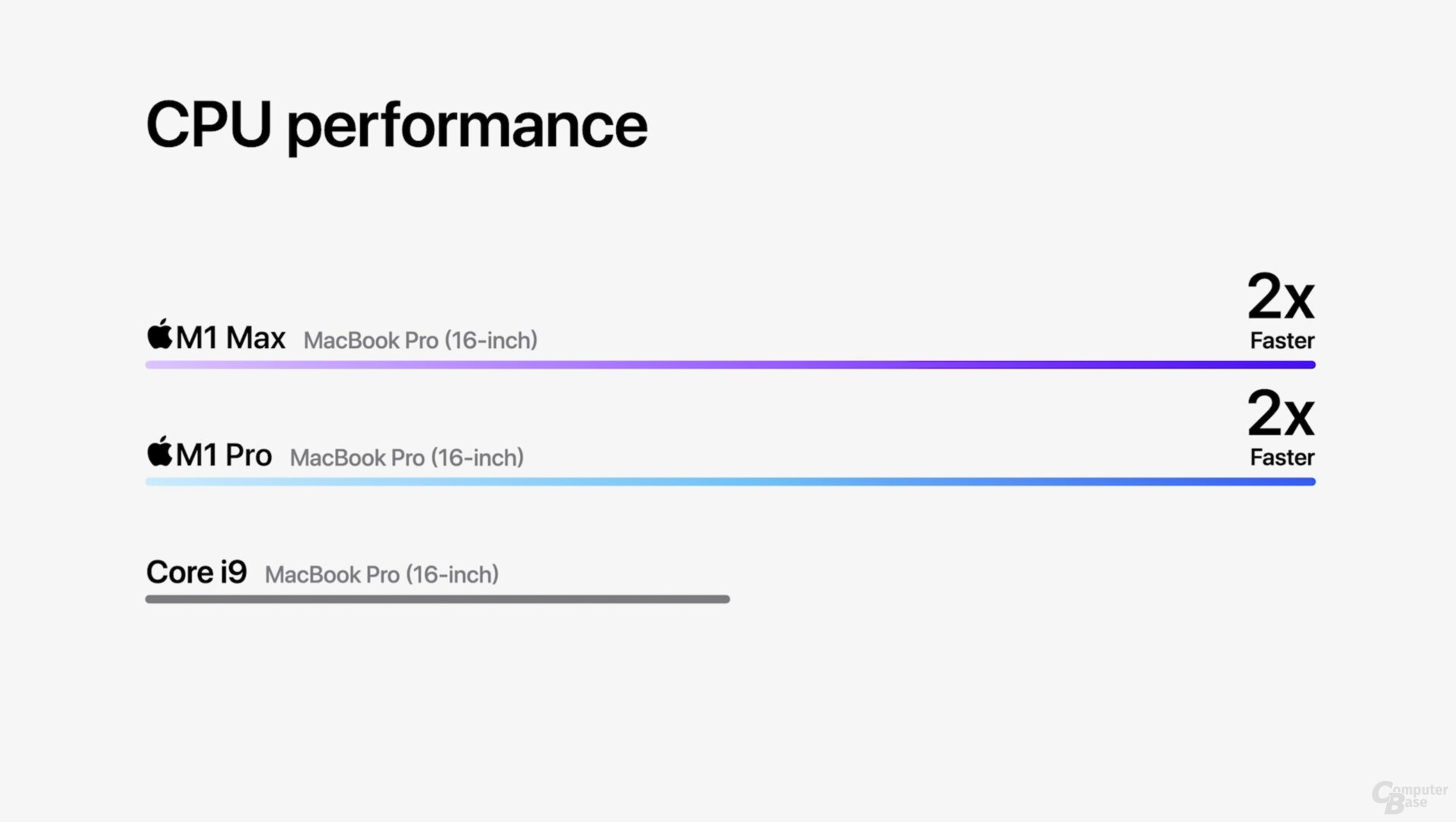 Apple wants to significantly accelerate the MacBook Pro with M1
Apple wants to significantly accelerate the MacBook Pro with M1
Image 1 of 2
< figure class = "thumbs thumbs - 2" role = "group">
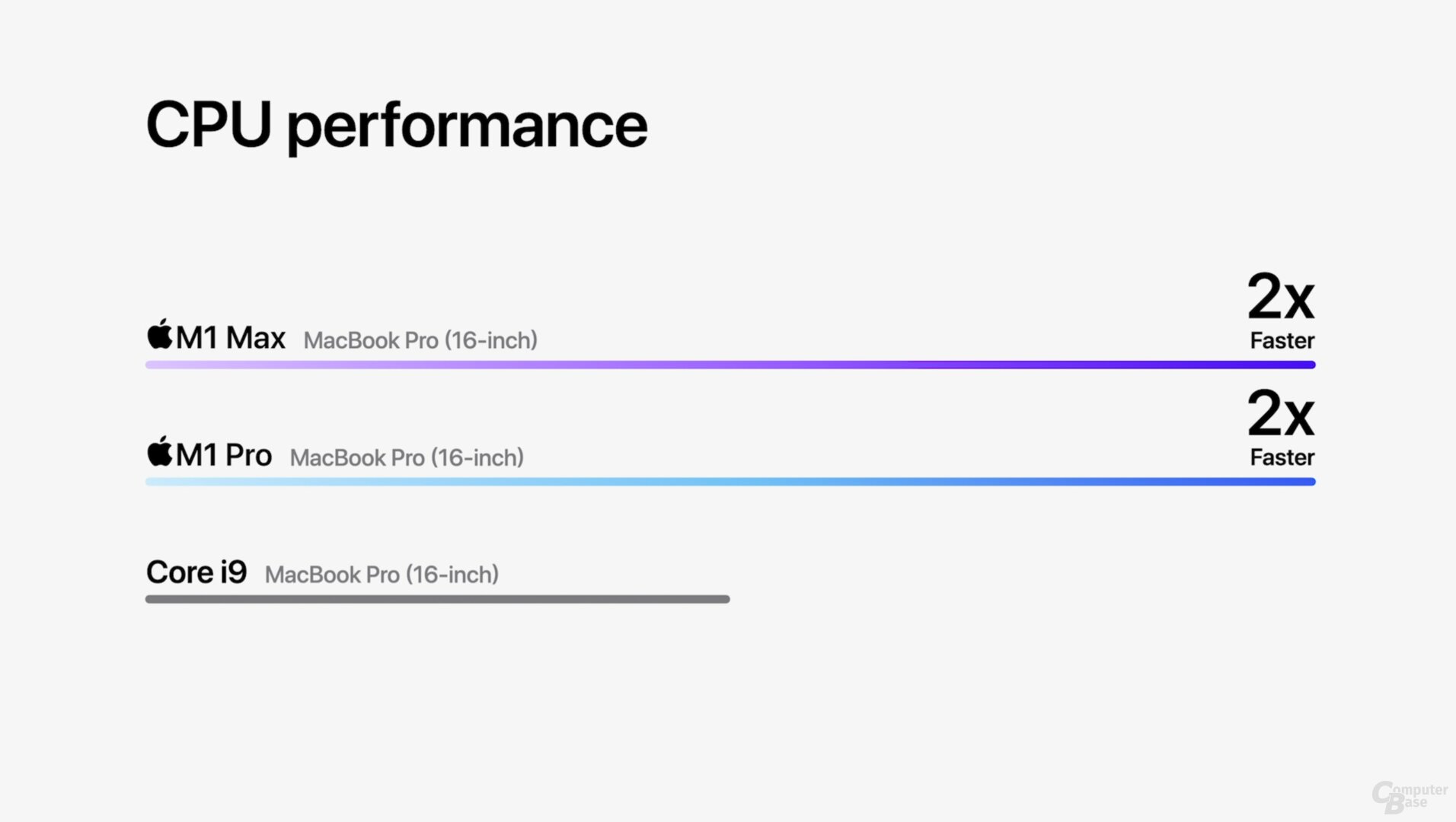 Apple wants to significantly accelerate the MacBook Pro with M1
Apple wants to significantly accelerate the MacBook Pro with M1 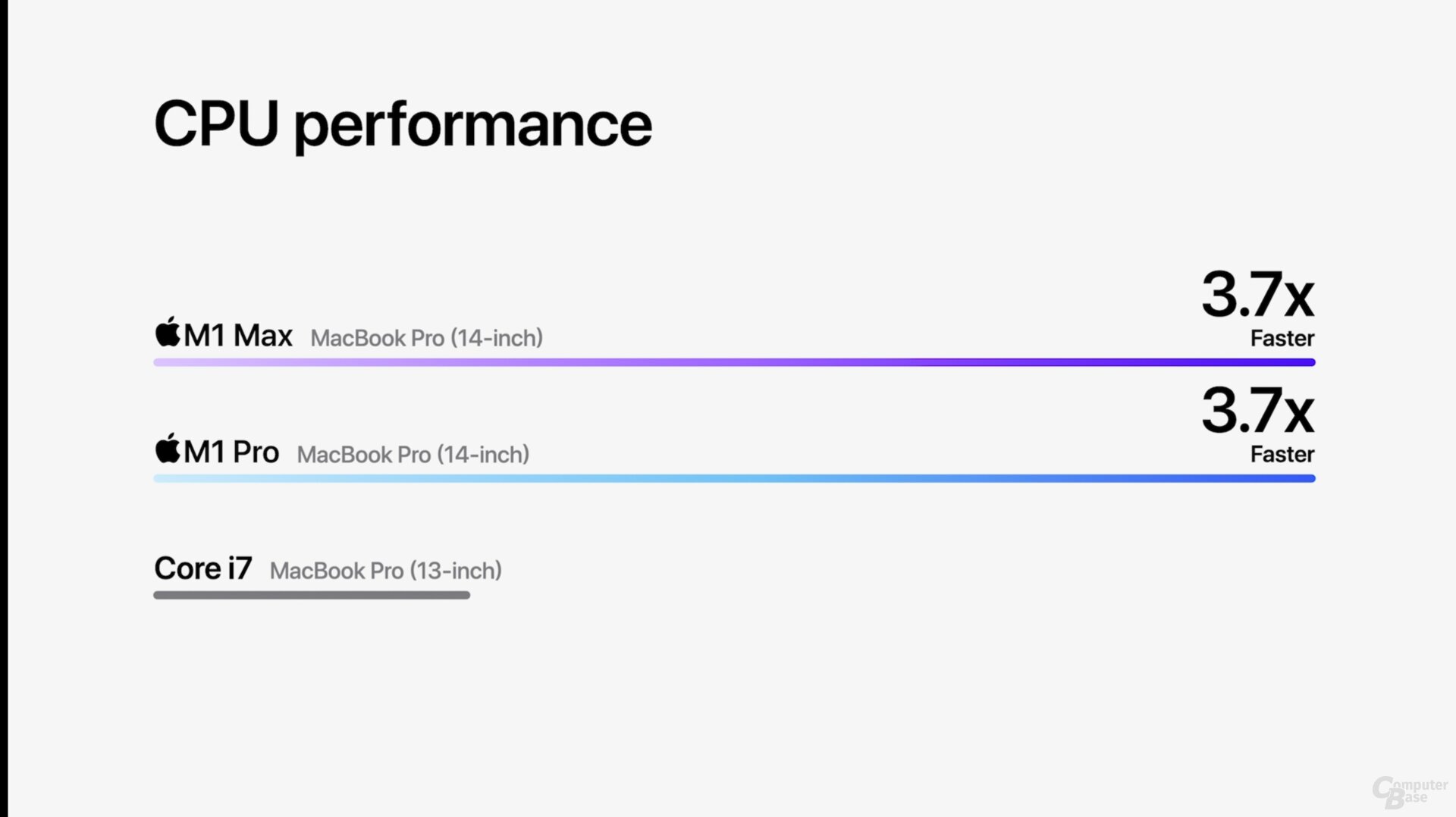 Apple wants to significantly accelerate the MacBook Pro with M1
Apple wants to significantly accelerate the MacBook Pro with M1 Overnight entries of the new M1 Max in Geekbench provided a first indication of where the CPU is headed. With around 1,750 points in the single-core run, the M1 Max is hardly faster than the M1 with an identical architecture, and the maximum turbo rate should also be the same in the end. In the multi-core benchmark, the M1 Max again gained around 12,000 points by almost 60 percent compared to the M1. No current notebook chip from AMD or Intel, no matter how high the TDP, has so far only cracked the 10,000 point mark in the editorial team. And in the single-core run, the M1 was already the front runner.
«Previous Geekbench 5.1 – Multi-Core TotalGeekbench 5.1 – Single-Core Total Next»
- 31 entries Geekbench 5.1 – Multi-Core Total Unit: Points
-
- Apple M1 Max (10/32) 12,000
- MSI GE76 Raider (Core i9-11980HK, 95 W) 9.644
- XMG Neo 15 (Core i7-11800H, 120 W) 9.378
- Asus ROG Flow X13 (Ryzen 9 5980HS, 80W) 8.506
- Asus ROG Flow X13 (Ryzen 9 5980HS, 42W) 8,434
- XMG Core 15 (Ryzen 7 5800H 80 W) 8,405
- XMG Neo 15 (Core i7-11800H, 35 W) 8.175
- Asus ROG Flow X13 (Ryzen 9 5980HS, 35W) 8.158
- Asus ROG Strix G15 (Ryzen 9 5900HX, 95 W) 7,770
- Apple M1 (8/8) 7,700
- MSI GE76 Raider (Core i9-11980HK, 30 W) 6,670
- Schenker Vision 15 (Core i7-1165G7, 40W) 5,803
- Schenker Vision 15 (Core i7-1165G7, 28W) 5.217
- Asus TUF Dash 15 (Core i7-11370H, 62W) 5.141
- ASRock Mars 4500U (Ryzen 5 4500U, 15 watts) 4,815
-
- 32 entries Geekbench 5.1 – Single-Core Total Unit: Points
-
- Apple M1 Max (10/32) 1,745
- Apple M1 (8/8) 1,730
- MSI GE76 Raider (Core i9-11980HK, 95 W) 1,661
- MSI GE76 Raider (Core i9-11980HK, 30 W) 1.633
- Schenker Vision 15 (Core i7-1165G7, 40W) 1.581
- XMG Neo 15 (Core i7-11800H, 120 W) 1,580
- XMG Neo 15 (Core i7-11800H, 35 W) 1,577
- Asus TUF Dash 15 (Core i7-11370H, 62W) 1.568
- Schenker Vision 15 (Core i7-1165G7, 28W) 1.567
- Asus ROG Flow X13 (Ryzen 9 5980HS, 42W) 1.515
- Asus ROG Flow X13 (Ryzen 9 5980HS, 35W) 1.499
- Asus ROG Flow X13 (Ryzen 9 5980HS, 80W) 1,496
- Asus ROG Strix G15 (Ryzen 9 5900HX, 95 W) 1,471
< li class = "chart__row"> XMG Core 15 (Ryzen 7 5800H 80 W) 1.450
< li class = "chart__row chart__row - hidden toggle-body-item nojs-tr">XMG Core 15 (Core i7-10750H, 45 W) 1.234
-
- ASRock Mars 4500U (Ryzen 5 4500U, 15 watts) 1,124
GPU performance
Apple also uses the two perspectives of performance per watt and consumption at maximum performance of the competitor model for the outlook on the GPU performance. The first comparison with the M1 Pro is aimed at Intel's current iGPU based on Xe, once again the Core i7-11800H in the MSI notebook is the inspiration. However, Intel's H processors only use a 32 EU variant of the Xe GPU, while the top models of the U series have 96 and thus three times the number of execution units. Apple wants to beat the minimum expansion at 30 watt power loss of the M1 Pro by a factor of seven.
 The comparison with Intel's smallest Xe-GPU lags a bit
The comparison with Intel's smallest Xe-GPU lags a bit This already makes it clear: Apple is not only focusing on iGPUs, the manufacturer also wants to overtake dedicated mobile GPUs from AMD and Nvidia and make them obsolete in the MacBook Pro. In a second comparison, Apple compared the M1 Pro with the Lenovo Legion 5 (82JW0012US), which uses a Ryzen 7 5800H and an Nvidia GeForce RTX 3050 Ti laptop GPU with 90 watt TGP. The M1 Pro is said to beat this system in GPU applications, although the consumption is less than a third.
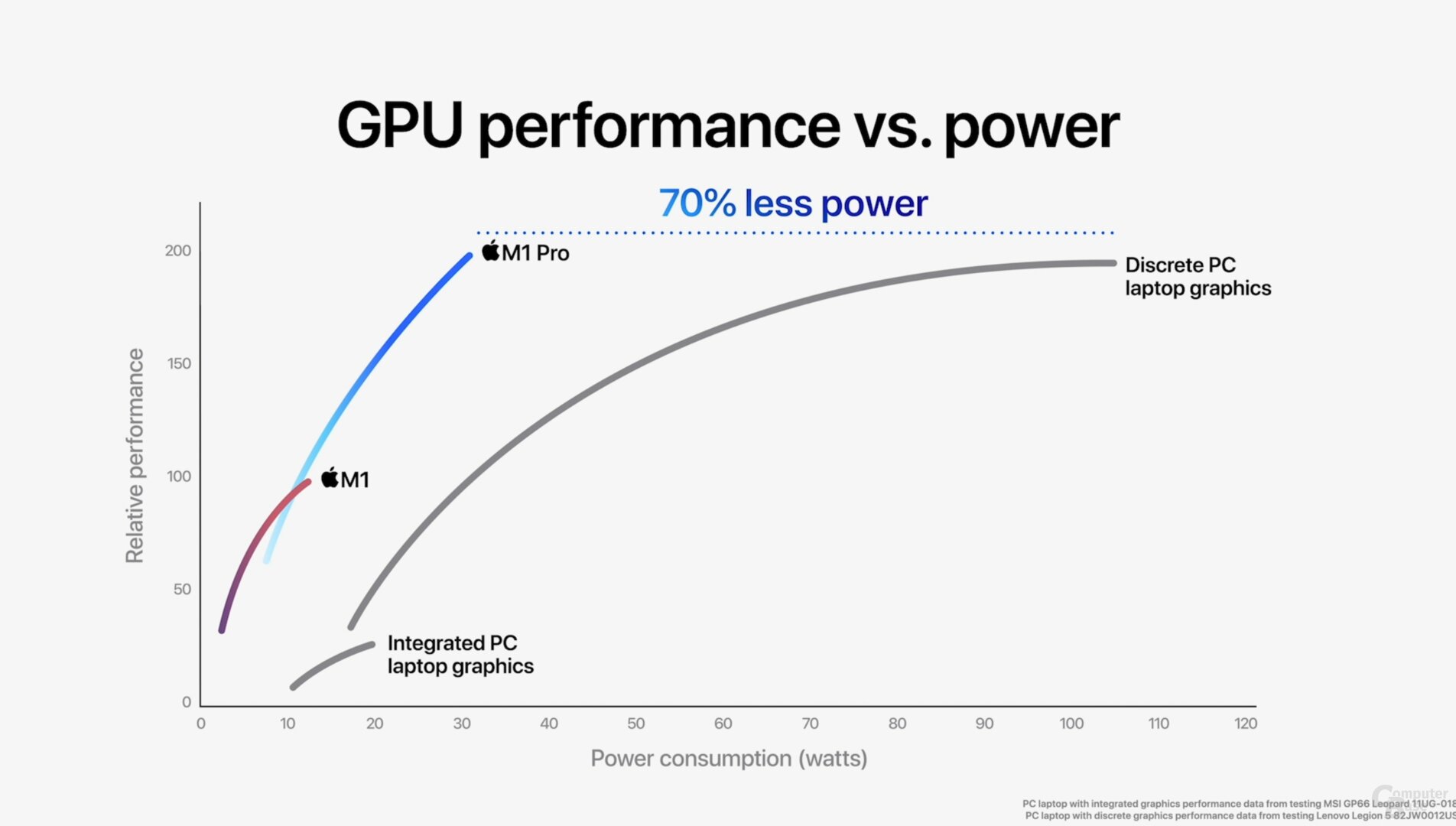 The M1 Pro should beat a GeForce RTX 3050 Ti laptop GPU with 90 watts
The M1 Pro should beat a GeForce RTX 3050 Ti laptop GPU with 90 watts With the M1 Max, which once again offers twice as many ALUs when fully equipped, Apple even wants to scare the full-blown mobile GPUs from Nvidia. A GeForce RTX 3080 laptop GPU with the maximum permitted TGP of 150 + 15 watts in the MSI GE76 Raider 11UH was used for comparison. Apple says: The M1 Max can almost match the performance of the Nvidia GPU with 100 watts less consumption. It makes no difference whether the MacBook Pro is powered from the mains or from the battery. Windows notebooks with large GPUs, on the other hand, usually have to significantly reduce their performance when they draw power from the battery because their consumption is too high to be satisfied from the battery.
-
 And use 100 watt less
And use 100 watt less
Image 1 of 2
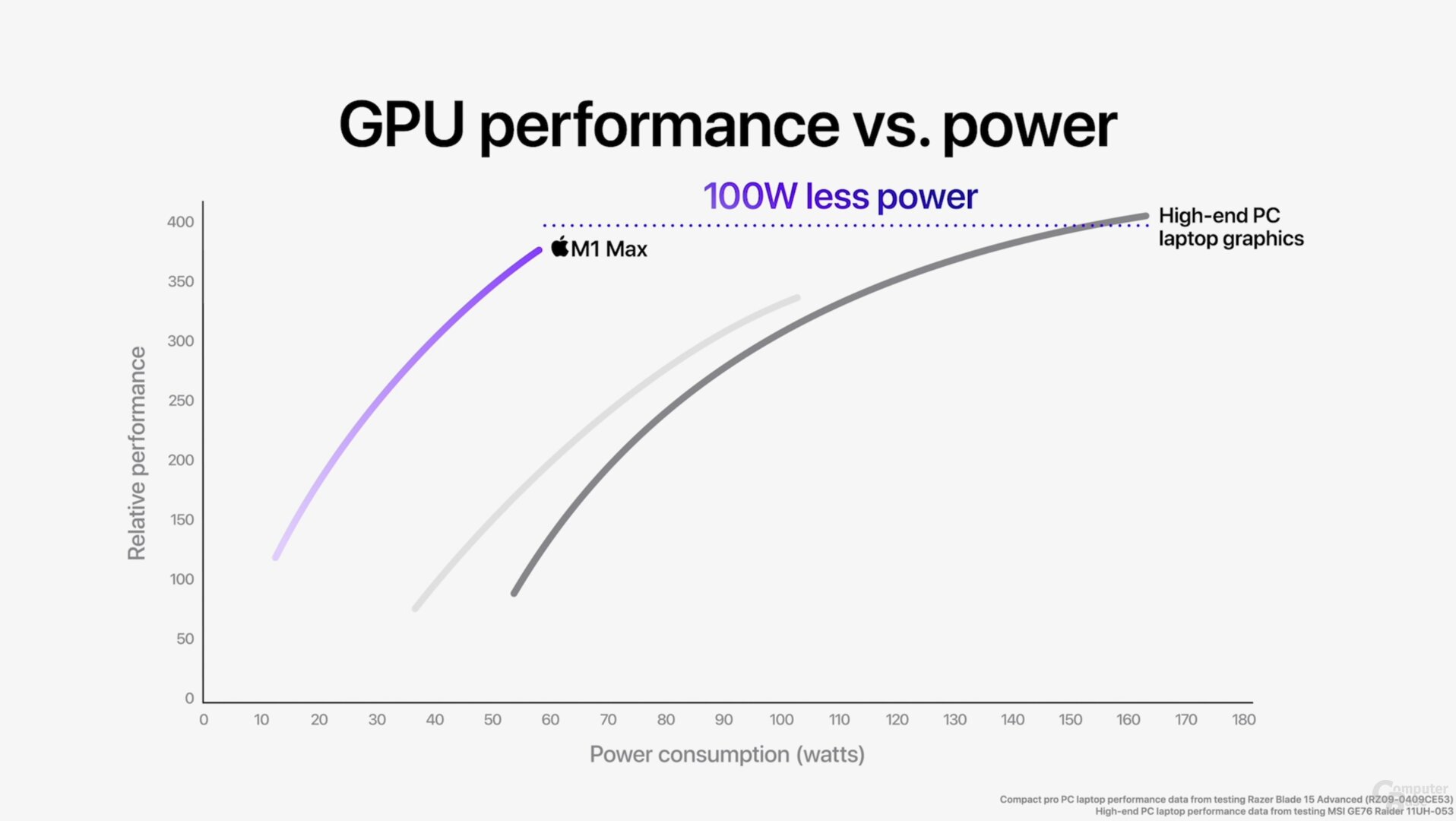 And use 100 watts less at the same time
And use 100 watts less at the same time 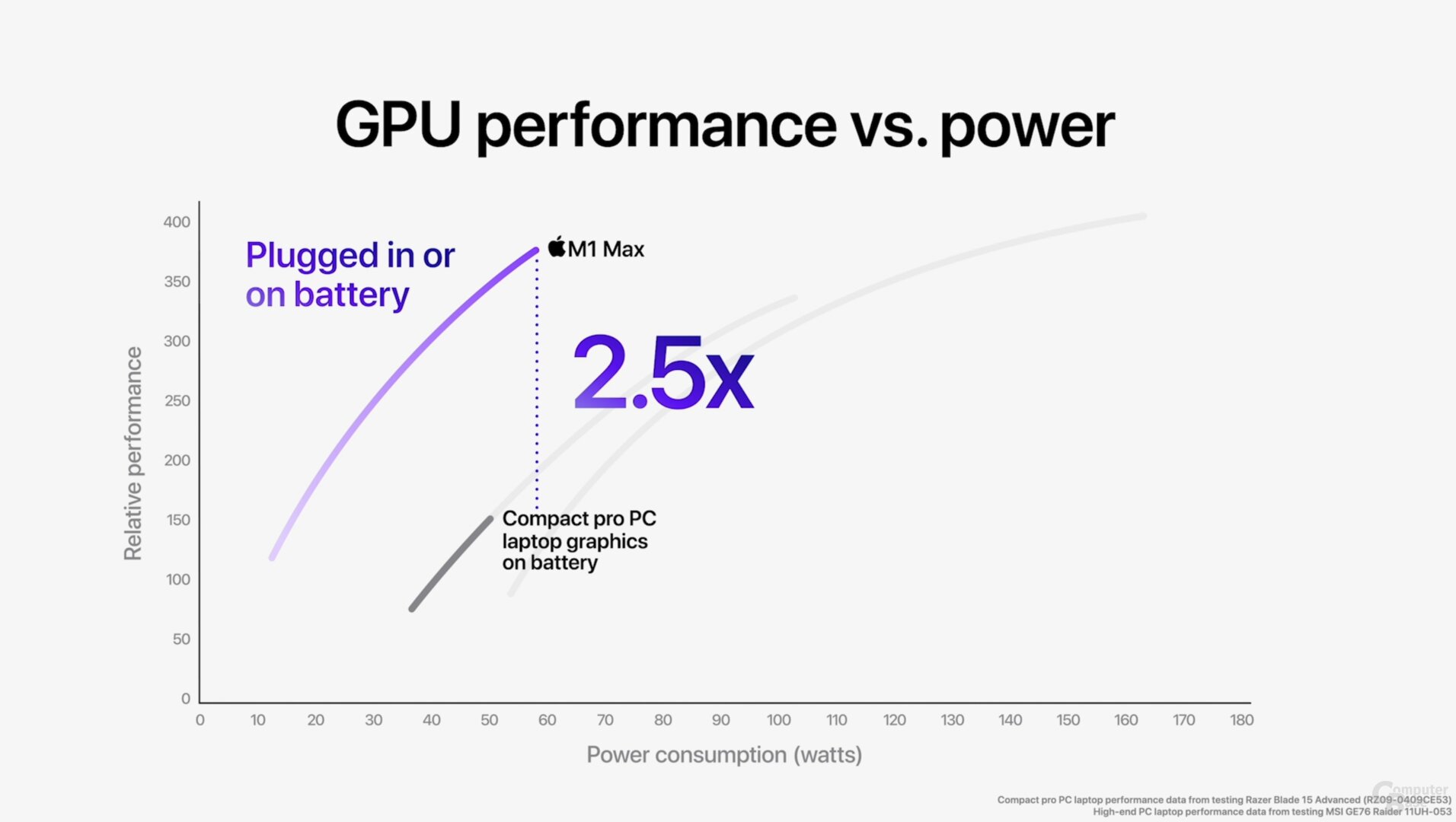 With the M1 Max even a GeForce RTX 3080 laptop GPU with 150 + 15 watts should come into trouble
With the M1 Max even a GeForce RTX 3080 laptop GPU with 150 + 15 watts should come into trouble According to the graphics provided by Apple, the M1 Max consumes between 50 and 60 watts under GPU full load, which – again based on the provided display – would not exactly correspond to twice the consumption of the M1 Pro. In view of the fact that the identical CPU in both SoCs also consumes power, this seems quite logical.
The picture drawn by Apple is not yet clear
The technical key data and performance outlooks presented by Apple on Monday evening with a lot of gloss should not hide the fact that the picture of all the high-gloss films still remains blurred despite all of the glossy films. Apple has not published any details about the benchmarks or the exact configuration of the comparison models. Only independent benchmarks will be able to provide clarity about how the M1 Pro and M1 Max fare in everyday life and then also in comparison to Intel Core, AMD Ryzen, AMD Radeon and Nvidia GeForce. The fact that Apple's platform relies on macOS, but the competition usually relies on Windows, will not make the analysis easy, as was the case with the M1.
The Mac Pro also seems possible
Even without conclusive statements about the performance, it seems to be already clear: The architecture behind the Apple M1 is highly scalable, even significantly more powerful versions for iMac Pro and Mac Pro no longer seem to be ruled out after the introduction of the M1 Pro and M1 Max. And all on the basis of the ARM architecture, which has not gained a foothold in the Windows world to this day, because there were neither particularly powerful nor particularly energy-efficient processors on this basis.
In the M1 generation, Apple is likely to have presented the planned silicon portfolio in its entirety with yesterday's keynote, because beyond the“ Max ”expansion stage, at least the iPhone has not recently been another stronger model. Or will there still be a kind of “M1 Ultra” with rumored 32 performance cores and 128-core GPU for the (i) Mac Pro or will the next Apple processors appear in a new “M2 series”? All Macs should switch to Apple Silicon by the end of next year.

